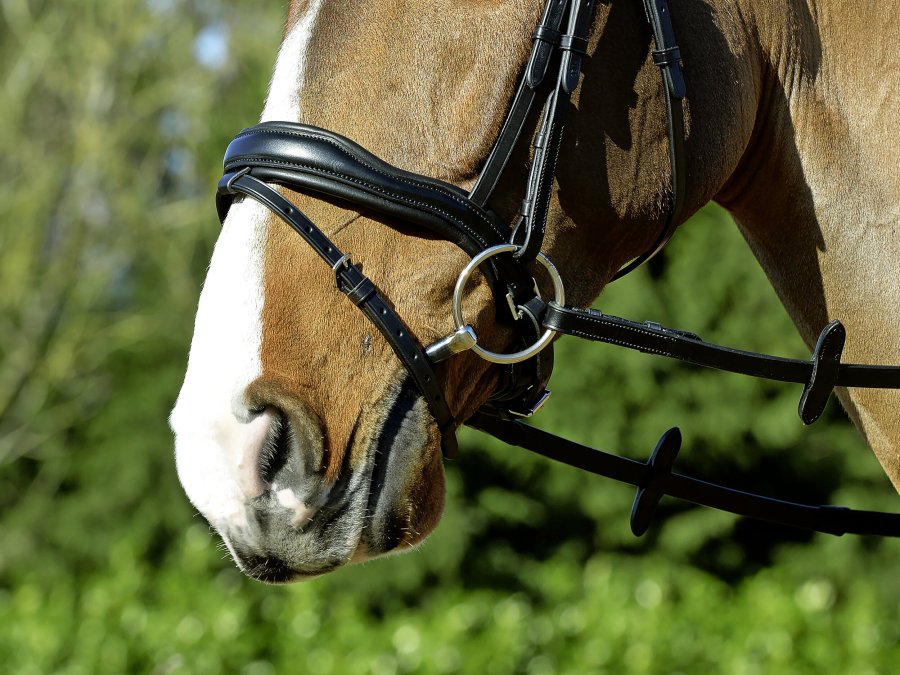Bridle fit is often overlooked despite the huge influence it can have on our horses’ performance and welfare, according to equine vet and researcher, Dr Rachel Murray.
She said that while equestrians have been paying increased attention to bit and noseband tightness, there has been less discussion to the bridle as a whole.
The bridle sits over muscle, nerves and blood vessels, and the horse’s teeth, so poorly fitting bridles can have adverse affects and even alter gait, as Dr Murray’s research has revealed.
Nineteen competition horses were involved in the study, where pressure mats were placed underneath the headpiece, noseband, throatlash and cheek pieces of the bridle.
For jumping horses, each stride recorded higher and lower pressure behind ear and under the headpiece, but no pressure was recorded during flight.
The most pressure was caused by horse pushing up on the ground, sending up a “wave” to the bridle.
For dressage horses, the headpiece was “quite unstable and rocking” between each stride between wing of the altas and the back of the ear.
Pressure to the base of both the ears occurred at the same point in each stride.
Dr Murray found the horses were affected by the type of headpiece, with wide headpieces more likely to have impact at the wing of the altas and the back of the ear.
A rolled bridle resulted in “very high” pressures at top of head.
Pressures were also influenced by the position of horse’s head, with a more vertical head position, as in dressage, the noseband often pulled up on the top of horses head, while if nose was carried further out, as in jumping, more pressure was recorded on lower edge of the noseband.
“If noseband is close to facial crest, there is very little leeway for it to move, while lower down it avoids the nerves and puts less pressure on noseband-headpiece unit,” Dr Murray said.
“Padding decreased stability and could alter pressure locations, so just adding padding doesn’t necessarily make everything better.”
A traditional cavesson noseband was associated with asymmetric pressures, particularly between the leather and buckle, with increased pressure if it was narrow and under buckle if it was positioned on jaw bone.
Crank nosebands were found to have more symmetrical pressure, lower peak pressures and moved with the horse’s head, while a flash tended to have highest pressure in the most locations.
A tight flash pulled down on top of noseband and headpiece, and the flash strap itself recorded pressure under the attachment, buckle and chin.
Drop nosebands recorded relatively low pressure in comparison to the flash, while a Mexican grackle, when well-fitted, tended to lower pressure.
Optimising comfort
A new bridle was designed based on the findings of the pressure pad research.
It included a wide middle section of headpiece to distribute pressure, narrow areas on sides to decrease pressure at side of the ears and front of the wings of the atlas, and padding around areas of pressure to lift the bridle from the horse’s head. Large rings at the side of the noseband allowed it to move with the horse.
This bridle was tested by recording pressure points and the movement of the horse.
“The modified bridle significantly smoothed out pressure points under the headpiece and noseband,” said Dr Murray.
“We also found a significant affect of the modified bridle on horses’ movement compared to horses own well-fitted bridle.”
The modified bridle gave four percent more forelimb protraction, four percent more carpal (knee) protraction and three-and-a-half percent more hock flexion.
“With a standard bridle we are potentially interfering with muscle attachments and nerve areas, and these are areas which can affect flexion of the head and protraction of the forelimb,” added Dr Murray.
Bridle fitting tips
Dr Murray said riders should consider the following when assessing bridle fit:
- Horses have different head shapes, so the bridle needs to suit their individual conformation
- Assess the bridle, bit and horse’s anatomy as a whole
- Horses don’t always have symmetrical faces, so this also needs to be considered
- Anatomical prominences, like an enlarged tooth in young horse or an abnormality, could cause a pressure point, and padding or a change in noseband type could make significant difference
Mr Murray added that routine, tailored dental was essential, whether or not the horse is wears a bridle.
Dr Murray’s talk, ‘The importance of bridle fit for optimal equine welfare and performance’ took place at the Saddle Research Trust Conference on 14 December.









